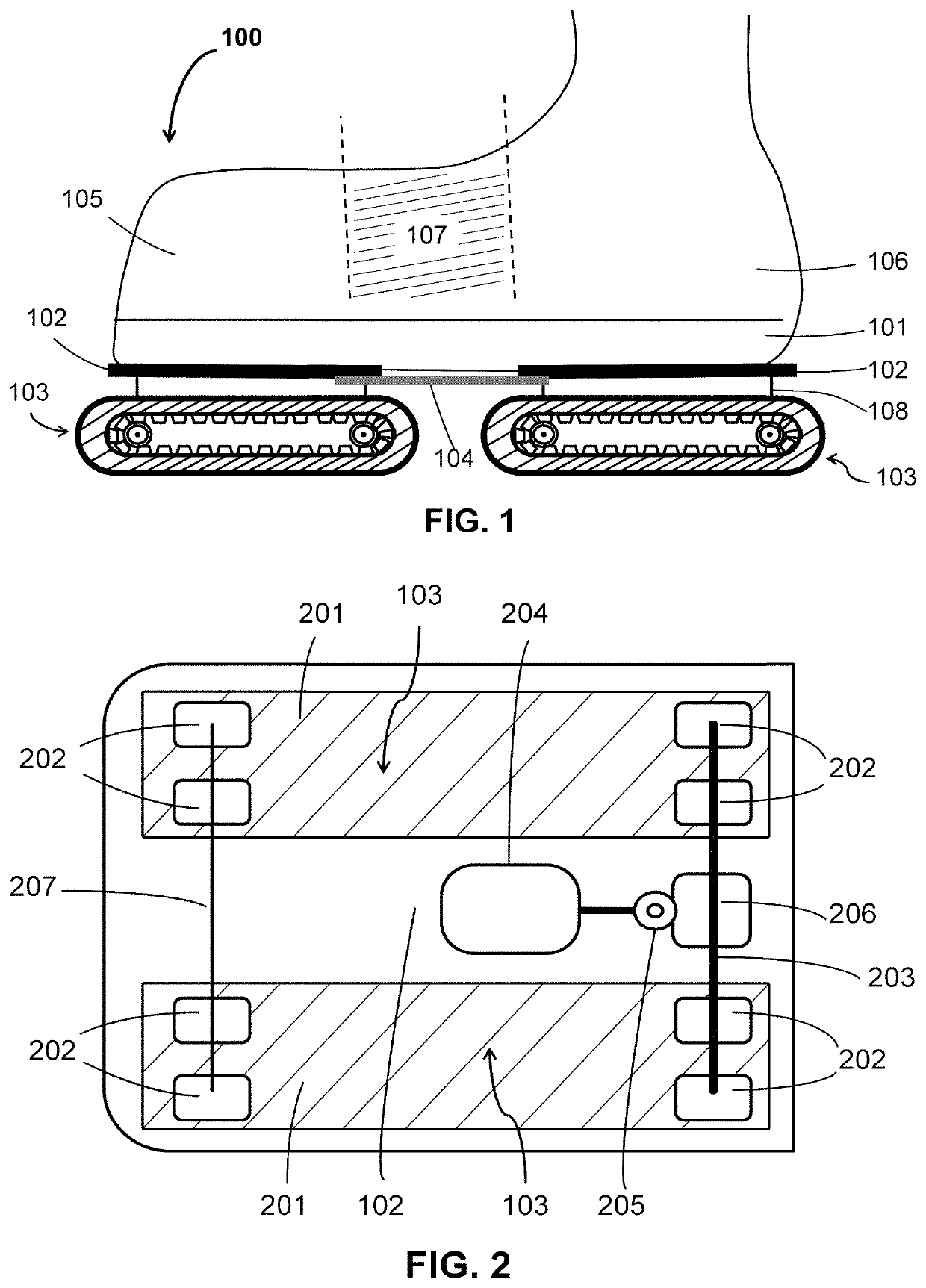Motorized walking shoes
a technology for walking shoes and shoes, applied in the direction of skates, sports equipment, etc., can solve the problem that the user of power-assisted footwear has limited control over the speed of the footwear, and achieve the effect of preventing substantial twisting
- Summary
- Abstract
- Description
- Claims
- Application Information
AI Technical Summary
Benefits of technology
Problems solved by technology
Method used
Image
Examples
first embodiment
[0085]In a first embodiment depicted in the third graph 1303 of FIG. 13A, the speed of the supplementary motion provided by the motorized walking shoes 100, Sc,t, is steady within each step and is equal to the difference between the user's intended walking speed, Si,t, at the beginning of a given step and the speed that is strictly contributed by the user's walking motion, Su,t, at the beginning of that same given step. Here as well, the speed of the first shoe 100 is shown with a continuous line 1309, while the speed of the second shoe 100 is shown with a dashed line 1310, and the shoe 100 that has a positive Sc,t is always the one that is lying on the underlying surface. In the present embodiment, the speed of the supplementary motion provided by the motorized walking shoes 100 is determined at discrete intervals, at the beginning of each time unit. Although this embodiment involves relatively abrupt transitions that may destabilize some users, it features the benefit of more imme...
second embodiment
[0086]In a second embodiment depicted in the fourth graph 1304 of FIG. 13A, the speed of the supplementary motion provided by the motorized walking shoes 100, Sc,t, is gradually adjusted on a continuous basis and is equal to the difference between the user's intended walking speed, Si,t-1, at the previous time unit and the speed that is strictly contributed by the user's walking motion, Su,t-1, at the previous time unit. As previously mentioned, in the present embodiment, Sc,t=Si, t-1−Su,t-1=(X−1) Su,t-1. Here as well, the speed of the first shoe 100 is shown with a continuous line 1311, while the speed of the second shoe 100 is shown with a dashed line 1312, and the shoe 100 that has a positive Sc,t is always the one that is lying on the underlying surface. Although this embodiment involves a greater lag before the user's actual walking speed equals the user's intended walking speed, Si,t, it features smoother speed transitions.
third embodiment
[0087]In a third embodiment depicted in the first graph 1351 of FIG. 13B, Su,t for a given time unit is assessed or calculated with reference to the peak speeds 1307, and the speed of the supplementary motion provided by the motorized walking shoes 100, Sc,t, is immediately adjusted at each mid-step for the shoe 100 that is lying on the underlying surface. In the present embodiment, immediately upon assessment at a mid-step of a new intended speed by the user, the speed of the supplementary motion provided by the motorized walking shoes 100, Sc,t, becomes equal to the difference between the user's newly-assessed intended walking speed, Si,t, at the mid-step and the overall speed that is strictly contributed by the user's walking motion, Su,t, at the mid-step. Here as well, the speed of the first shoe 100 is shown with a continuous line 1355, while the speed of the second shoe 100 is shown with a dashed line 1356, and the shoe 100 that has a positive Sc,t is always the one that is ly...
PUM
 Login to View More
Login to View More Abstract
Description
Claims
Application Information
 Login to View More
Login to View More - R&D
- Intellectual Property
- Life Sciences
- Materials
- Tech Scout
- Unparalleled Data Quality
- Higher Quality Content
- 60% Fewer Hallucinations
Browse by: Latest US Patents, China's latest patents, Technical Efficacy Thesaurus, Application Domain, Technology Topic, Popular Technical Reports.
© 2025 PatSnap. All rights reserved.Legal|Privacy policy|Modern Slavery Act Transparency Statement|Sitemap|About US| Contact US: help@patsnap.com



